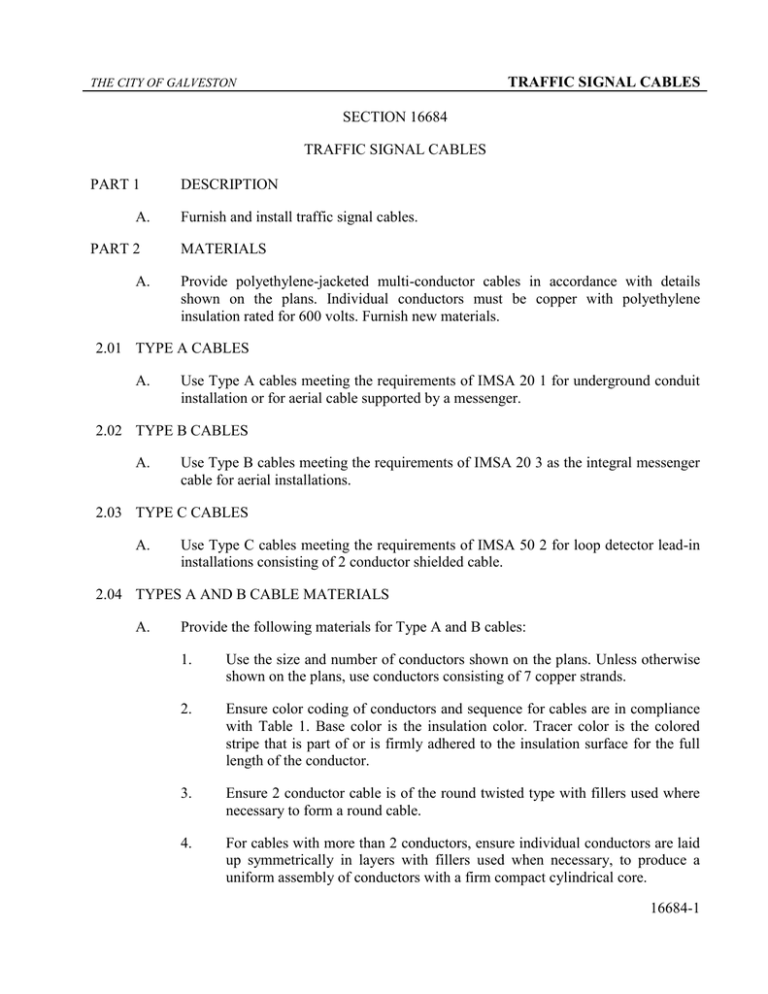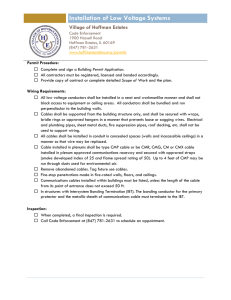TRAFFIC SIGNAL CABLES 16684-1 SECTION
advertisement

TRAFFIC SIGNAL CABLES THE CITY OF GALVESTON SECTION 16684 TRAFFIC SIGNAL CABLES PART 1 A. PART 2 A. DESCRIPTION Furnish and install traffic signal cables. MATERIALS Provide polyethylene-jacketed multi-conductor cables in accordance with details shown on the plans. Individual conductors must be copper with polyethylene insulation rated for 600 volts. Furnish new materials. 2.01 TYPE A CABLES A. Use Type A cables meeting the requirements of IMSA 20 1 for underground conduit installation or for aerial cable supported by a messenger. 2.02 TYPE B CABLES A. Use Type B cables meeting the requirements of IMSA 20 3 as the integral messenger cable for aerial installations. 2.03 TYPE C CABLES A. Use Type C cables meeting the requirements of IMSA 50 2 for loop detector lead-in installations consisting of 2 conductor shielded cable. 2.04 TYPES A AND B CABLE MATERIALS A. Provide the following materials for Type A and B cables: 1. Use the size and number of conductors shown on the plans. Unless otherwise shown on the plans, use conductors consisting of 7 copper strands. 2. Ensure color coding of conductors and sequence for cables are in compliance with Table 1. Base color is the insulation color. Tracer color is the colored stripe that is part of or is firmly adhered to the insulation surface for the full length of the conductor. 3. Ensure 2 conductor cable is of the round twisted type with fillers used where necessary to form a round cable. 4. For cables with more than 2 conductors, ensure individual conductors are laid up symmetrically in layers with fillers used when necessary, to produce a uniform assembly of conductors with a firm compact cylindrical core. 16684-1 THE CITY OF GALVESTON TRAFFIC SIGNAL CABLES 5. Ensure fillers are a non-metallic, moisture-resistant, non-wicking material. 6. Supply conductor assemblies that are covered with a wrapping of a moistureresistant tape applied to overlap at least 10% of the tape width. 7. Ensure that the taped conductor assembly is covered with a tightly fitting black polyethylene jacket that is smooth and free from holes, splits, blisters, and any other imperfections. 8. Supply cables that clearly show the name of the manufacturer and the IMSA specification number applied at approximate 2 ft. intervals to the outer surface of the jacket by indent printing. Table 1 Conductor Color and Sequence for Cables Conductor No. Base Color Tracer Color 1 Black 2 White 3 Red 4 Green 5 Orange 6 Blue 7 White Black 8 Red Black 9 Green Black 10 Orange Black 11 Blue Black 12 Black White 13 Red White 14 Green White 15 Blue White 16 Black Red 17 White Red 18 Orange Red 19 Blue Red 20 Red Green 21 Orange Green 2.05 ADDITIONAL REQUIREMENTS FOR TYPE B CABLE MATERIALS A. Additional material requirements particular to Type B cable are as follows: 16684-2 THE CITY OF GALVESTON TRAFFIC SIGNAL CABLES 1. Ensure cables consisting of 5 or more conductors have a 0.25 in. nominal diameter messenger. For the messenger, use Class A galvanized Extra High Strength Steel Strand with 3 or 7 wires. 2. A solid strand messenger with 0.134 in. diameter may be used for cables with less than 5 conductors. 3. To provide corrosion protection, ensure the messenger strand is coated and the interstices are flooded with a rubber asphalt compound or equivalent. 4. Ensure the integral messenger and conductors are enclosed in the jacket forming a cross section similar to a figure 8. 2.06 TYPE C CABLE MATERIALS A. Use the following materials for Type C cables: 1. Unless otherwise shown on the plans, use No. 14 AWG insulated conductors with concentric stranding with black insulation on 1 of the 2 conductors and clear insulation on the other conductor. Ensure conductors have a minimum of 2 twists per foot within the cable. 2. Use cables that have 100% shield coverage utilizing aluminum bonded to a Mylar film. Ensure the drain wire is stranded tinned copper, 2 AWG sizes less than the conductor, and in continuous contact with the aluminum side of the shield material. 3. Ensure the jacket is black polyethylene. 4. Use cables that legibly show the name of the manufacturer and the IMSA specification number applied at approximate 2 ft. intervals on a tape under the outer jacket. 2.07 SAMPLING A. PART 3 The Owner’s Representative may take samples from each roll of each size of cable for establishing conformity to IMSA. The samples will be at least 3 ft. in length. Replace any cable failing to meet IMSA requirements. CONSTRUCTION A. For each cable run in underground conduit, coil an extra 5 ft. of cable in each ground box. B. Splices are not permitted in Type A and B cables unless shown on the plans or approved by the Engineer in writing. Ensure that splices are watertight. 16684-3 TRAFFIC SIGNAL CABLES THE CITY OF GALVESTON C. Make splices between Type C cable and loop detector wires only in the ground box near the loop the cable is servicing. Use non-corrosive solder for splices. Ground the drain wire of Type C cable to earth ground only at the controller or detector cabinet. Ensure the resistance from the drain wire to the ground rod is less than 1 ohm. D. Test the cables after installation and prior to any connection to the cables. Cables testing less than 50 megohms insulation resistance at 500 volts will be rejected. PART 4 MEASUREMENT A. This Item will be measured by the foot of traffic signal cables. B. This is a plans quantity measurement Item. The quantity to be paid is the quantity shown in the proposal. Additional measurements or calculations will be made if adjustments of quantities are required. PART 5 PAYMENT A. The work performed and materials furnished in accordance with this Item and measured as provided under “Measurement” will be paid for at the unit price bid for “Traffic Signal Cables” of the types and sizes specified. This price is full compensation for furnishing and installing materials and for equipment, labor, tools, and incidentals, except as shown below. B. Cables inside traffic signal pole assemblies will be paid for under this Item. C. Cables used for inside signal heads and controllers or for coils in ground boxes, pole bases, and on span wires will not be paid for directly but will be subsidiary to pertinent Items. END OF SECTION 16684-4


